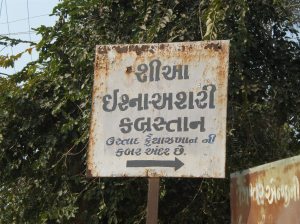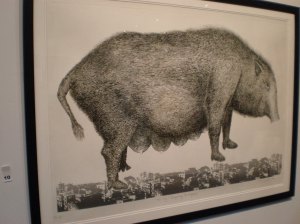[Update: I have also posted this piece on a new blog that I intend to contribute to: Peepul Tree]
Among the fondest of my memories of growing up in Baroda are those of attending many a Hindustani Classical Music concert at the Darbar Hall of the Laxmi-Vilas Palace. To have listened to music in that grand setting is to have partaken in the most singular of pleasures the city of Baroda has to offer. Built in 1890 by Maharaja Sayajirao Gaekwad III, the Laxmi-Vilas Palace was – and parts of it continue to be – the home of the erstwhile Gaekwad rulers of Baroda. The Darbar Hall, much like the eclectic architecture of the encompassing palace (Indo-Saracenic, or Indo-Islamic if you like), is anatomized by both western and oriental elements; in the words of Ghulam Mohammed Sheikh, an “east-west jugalbandi of art and architecture”. The grand Venetian mosaic on the facade, the marble and ceramic floors, the enameled ceiling, the ornate wooden balconies, all hang together “curiously, in what appears to be a heterogenous whole”.
The most memorable aspect of concert recitals in the Darbar Hall, is the extraordinary twinning of music and setting that endures in those moments (alas, never long enough!), to the exclusion of all else. Indeed Darbar Hall is grand, but it is in a strange way unimposing. It fulfills its purpose, “to not obtrude upon the eyes of the audience with any awe-inspiring opulence”.
Above all else, the Hall is a fitting venue for an audience such as that of Baroda. Unlike other places, the rasiks in Baroda more than measure up to the setting. I remember a concert in the winter of 2001 when, after singing a bada khayal in Yaman, Smt. Padma Talwalkar proceeded to take on the formidable Abhogi. No sooner had she uttered the very first few swaras in the aalaap, than a gasp of disapproval emerged from hundreds of people in the Hall. Apparently, Yaman had still not escaped the artist and she had mixed up her swaras. It was amazing to see so many people catch the error at once ! (and humbling on account of my own ignorance!) Quite a welcome contrast from the usual crowds, who seem to find the arrival of a frenetic tabalchi to sam, the only applaudable aspect of a vocal performance !
Perhaps the brightest weft in the rich tapestry of the musical history of Baroda is Ustad Faiyaz Khan saheb, the doyen of Agra gayaki. This fact became known to me only in the aftermath of the despicable desecration of his grave (mazaar) in Baroda in the Hindu-Muslim riots of 2002. Having been invited to be the court musician by Sayajirao in 1912, Khan saheb, although itinerant, remained in Baroda till his death in 1950.

I had wanted to visit his grave for a long time, and on a recent trip to Baroda decided to look it up. A search on the web yielded very little by way of location or directions. Most of the hits were episodic accounts of the vandalization of his grave (by throwing burning tyres, apparently). There were hardly any images. A friend, through an acquaintance at the Faculty of Performing Arts at M.S. University, found out that the mazaar was located on the road leading from Aradhana Cinema to Bahucharaji Temple in Karelibaug. We were asked to look for a gentleman named Ketan bhai, an auto mechanic whose automobile service station was in the vicinity of the mazaar and who would know its precise location.
On an incredibly warm January afternoon we drove to the area. Luckily for us Ketan bhai was not hard to find, and he led us to the mazaar, that stood right behind his service shop. I have to say that I was a bit anxious when it came time to ask Ketan bhai about the mazaar. In the context of the troubled history of religious violence in Baroda’s recent past, a sense of mutual suspicion and insecurity permeates the Hindu-Muslim relationship, and I felt a mild pang of fear asking Ketan bhai for the location of the mazaar. The fears were allayed immediately, when Ketan bhai welcomed us with a smile. He seemed rather surprised that someone was interested in visiting the mazaar. By his account, very few people had visited since 2002. Walking through strewn car parts, abandoned car carcasses, walls with lubrication oil smeared on them, we were led to a clearing behind the shop, where stood a white mausoleum with green grill-walls.

A few unmarked graves laden with flowers lay in front of Khan saheb’s mazaar. We were told that many of Khan saheb’s relatives were buried beside him. Khan saheb had never married. We walked around the grave for a while, had a peek inside, took a few pictures and paid our respects, and then lingered a little longer, imagining what the day must have been like when they brought this giant to rest here.
A dusty green cloth and a few scattered dried roses lay atop the tomb. The mazaar is apparently maintained by the Faiyyaz Khan Trust, although I don’t know anything about them. We were also told that a few distant relatives visit the grave on the anniversary of Khan saheb’s death. And although it wasn’t utterly abandoned, I couldn’t help but feel an enormous incongruity between the image of the handsome man with his deep voice and his regal countenance – the shining Sun in the musical firmament – with what lay in front of me. The fates that death brings !

I looked once again at the tombstone, but there was nothing I could understand. (If any reader who knows farsi/urdu, could please translate whats written on the tombstone, it would be much appreciated!).

One has to wonder why anyone would try and desecrate the mazaar of one of the jewels of Hindustani music. Its neglect and dereliction were shame enough on us. In the context of all else that happened in 2002, this was perhaps not the most egregious infraction. Given what happened to Wali Dakhani’s grave, perhaps we ought to be relieved that the mazaar exists at all. It’s likely that the hooligans who perpetrated this profanity must not have been aware of what they were doing, must surely have known nothing of Hindustani music – and how in India there isn’t a more perfect amalgam of the shared identity of Hindus and Muslims. If, on the other hand, they had known these things, then they couldn’t possibly have chosen a more hallowed ground to blaspheme on with their vile act. We may perhaps forgive that vandalism as the wrath of the impotent ignorant, but more needs to be done to bestow a certain dignity, in life certainly, but even in death, on our national treasures. Surely, this is not too much to ask of ourselves – we, who relish our 9%-a-year GDP growth.
Indeed, the question does arise: why must we take care of our dead? It is after all fair to ask, that in a country like ours why must the dead be so hopeful, when there is barely any room for the alive. I don’t know. But in a way, how we treat the departed and their memory is much less a judgment on them, than it is on us, the living.
On the topic, listen to an old interview of Khan saheb by Shri Vijay Kichlu on this site, and marvel at the sheer grace, the civility, the refinement of thought and the elevated use of language (and not the use of elevated language), and compare them to the voices on TVs in our own times: the shrill incompetent anchors and their sophomoric reporters who so relentlessly oppress us with their cacophony night-after-night, inflict on us their vacuities day-after-day. Could we expect any better? Most of our media cannot find a single writer to write a critical review of any contemporary concert performance. Most reports are amateur rubbish, bloated by their vulgar use of superlatives and emaciated in substance. Were it not for resources like Rajan Parikkar’s site, we would all be so utterly impoverished (I certainly would !)
We left, a little under an hour after we had arrived. Just a few meters from the mazaar, we heard again the clamor of the auto shop – the clanging of rods, little pieces of metal hammered into shape, holes being drilled, metals welded – which would perhaps continue until well after the sun had set. I was reminded of the final ashaar in a ghazal by Kaifi Azmi, “Khaar-o-khas toh uThein” which was written in the aftermath of religious violence in Ahmedabad in the early 90’s,
Khaar-o-Khas to uTheN, raastaa to chale
maiN agar thak gayaa, qaafilaa to chale
chaaNd, suuraj, buzurgoN ke naqsh-e-qadam
Khair bujhne do unko, havaa to chale
haakim-e-shahar, yah bhii koii shahar hai
masjideN band haiN, maiqadaa to chale
usko mazhab kaho yaa siyasat kaho!
Khudkushii ka hunar tum sikhaa to chale
itnii laasheN maiN kaise uThaa paauNgaa
aap iiNToN kii hurmat bachaa to chale
belche laao, kholo zamiiN ki taheN
maiN kahaaN dafan huuN, kuchh pataa to chale
Directions to the Mazaar from Vadodard Railway Station
Head towards the Kala Ghoda statue and make a right towards Kirti Mandir/ Raopura
Go down Raopura road past SSG hospital and make a left just before Aradhana Cinema towards Karelibaug/Bahucharaji temple
On this road, go past the crematorium and look for a sign in Gujarati on your left that says ‘ Shia Ishna-Ashari Kabristaan’
 [Update: I have also posted this piece on a new blog that I intend to contribute to: Peepul Tree]
[Update: I have also posted this piece on a new blog that I intend to contribute to: Peepul Tree]












